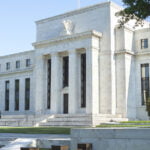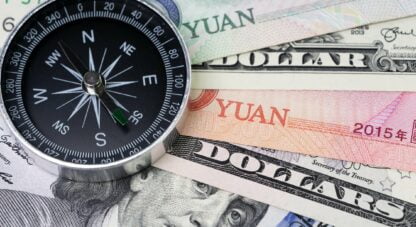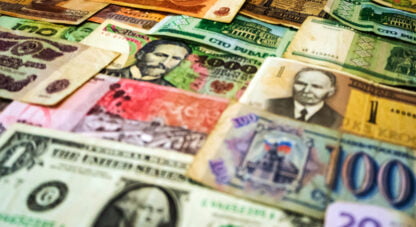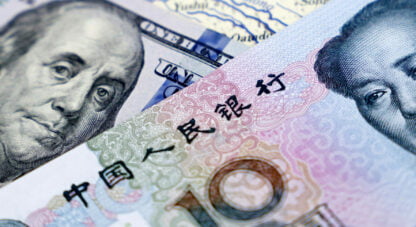Podcast: Play in new window
- Japan throws away 62 Billion in effort to save Yen from meltdown
- The Mexican Peso: Harsh judge of Mexico’s new President?
- Gold above $2300 gives the miners an abundance of profitability
“It really is all about the currency. The yen today, the peso tomorrow, the rand, the euro, the RMB, the dollar, the headlines will always be—the headlines will always be politicized. They will be dramatized, propagandized. Those are the headlines. But between the lines, the real story has and will continue to be in the currencies. And of course, your best universal tell for currency weakness is gold strength. The race to the bottom in fiat currencies will continue to be reflected in the strong pricing of gold and silver. Higher and higher they go. Where they stop, no one knows.” –David McAlvany
Kevin: Welcome to the McAlvany Weekly Commentary. I’m Kevin Orrick, along with David McAlvany.
David, I’ve got to tell you a story because yesterday I was pretty angry. I’ll give you a little backstory on this. We live in a beautiful area down here in Durango, but of course wildfires are an issue. And we got a letter from our insurance company a couple of months ago that said, “If you resolve six issues,” they had walked the property and they said, “If you resolve six issues on the house,” and it was actually some pretty expensive work, “we will renew your policy in August.” Well, we aggressively attacked all six issues and actually some other issues to bring the home up to fire compliance. And quite a bit of money was put toward that. And we got a letter yesterday that said, “Oh, we’re going to cancel it anyway.” So it was like, “Wow, that was a lot of wasted money. Now we’re fighting back, but I couldn’t help but think, Dave, that it’s a little like the Japanese right now. They’re spending billions of dollars to keep their yen from failing. How’s that working out?
David: Yeah, I mean 60 plus billion last month, and it didn’t do anything for the yen. I mean it’s a few points difference, but that’s a lot of money for very little traction. It reminds me that losses in one place emerge as costs somewhere else.
A family lesson learned long time ago, my in-laws ran a business in Texas and along the Gulf Coast. A bank that they worked with experienced catastrophic losses both from Enron and WorldCom. And so the dictate went down, because they lost so much money on Enron, it’s time to call in as many loans as possible. And they called in my in-laws’ loans—through no fault of their own, they never missed a payment. Didn’t matter. Losses in one place emerged as costs somewhere else, and I think we ultimately see that reflected in currencies.
Kevin: Okay. Do you think that’s maybe happening now with markets? Just a few months ago we were again in sort of a miniature everything bubble that was reminiscent of the everything bubble from a couple of years ago. But at this point we seem to be seeing some jittery weakness in unrelated areas.
David: Well, exactly. And I think most of the weakness in the financial markets is under the surface, sort of just under the surface. I mean, we’ve got equity prices, which have been impressively holding near all-time highs. The S&P 500 is roughly 10% higher for the year. Nasdaq-100 about the same. Semiconductors, that’s where you begin to see outperformance, 22% higher. And our risk indicators as we get together each week on the asset management side of our business, we look at those and they’re pretty well benign across the board. They would say, “There’s really no problem here.”
But I do note that on any disappointment, there’s been a shift in temperature, emotional temperature in the marketplace. The instinct is to sell first and ask questions later. Salesforce for instance, last week down 18% on lower quarterly revenue growth. Kohl’s was off 27% on an earnings miss. And Dell, they actually were in line with their earnings expectations, but they sold off 12% because it was not significantly higher as it had been in previous quarters. So it’s interesting, it has the feel of a market that has very high expectations and low to no tolerance for disappointment.
Previously anything was tolerated. We had sort of beer goggle analysis, which was acceptable. Everything looked beautiful. Now you need to deliver something of substance, and if it’s not radically better than expected, then you’re going to pay. Is that nervousness? Is that the market realizing that they’re a little bit too far over their skis? Sometimes I ski very fast and that probably doesn’t come as a surprise.
But what is too fast? You only really know if it’s too fast if you crash. I can tell you one thing. Whenever I leave the ground, I can instantly tell you if I’m off balance and I need to adjust. And the market has that feel. It’s off balance. It’s wanting to mid-course correct. Will the touchdown be smooth? Will it be disastrous? The price to pay for too much speed, for getting too far over your skis, that’s what I see in the market.
Kevin: So often a broker would say, “Okay, so you’re uncomfortable with the stock market. We’ll just go to bonds. We’ll go to fixed income.” But right now I’m wondering if there’s weakness there too.
David: It’s very similar. Below the surface, you’ve got issues in fixed income. It’s fascinating sort of the dichotomy between new issues which are brought to market and oversubscribed. So on the one hand you’d say, “No, no, no, the appetite’s very strong and everything’s fine.” Bank of America highlighted the weakness at the periphery of the US corporate bond market in recent days. And the bottom decile, they point out, so the bottom 10%, roughly $200 billion in debt, they’re worried about, they said, “probably won’t survive the current period of elevated rates.” If you think about that, they’re talking about companies, roughly 90 companies, half of which are free cash flow negative and sit at a debt to enterprise value of 85%. There’s virtually no equity value left, and they are about to prove Darwin correct in the fixed income markets.
Kevin: And with fixed income, the other vulnerability, as you know, is ratings because sometimes debt can be held if it’s got a particular rating. But if it’s downgraded, that downgrade could have a sweeping effect.
David: And there’s the ripple effects. The ripple effects are very interesting, is a scenario to play out in your mind. A lot of lower grade corporates right on the edge of investment grade status, that would come under pressure with a collapse of that bottom decile. So too much of the lower tier investment grade is in exchange traded products, ETFs, which have a product structure that implies liquidity, where liquidity doesn’t actually exist. So you buy it, you think you can turn around and sell it with a click of a mouse, and theoretically you can, but that means that there has to be a market maker on the other side. For that kind of debt instrument, there is no vast pool that you can sell into.
Financial Times earlier last week reported that rating agencies, their expectations of downgrades now exceed upgrades for the first time, I think going back to 2020 or 2021, in several years anyways. And the list of names on negative watch by the rating agencies has doubled from 2.9% to 5.7%. And the companies that are on positive watch has dropped from 7.8 down to 5.3.
So there has been an adjustment. We’re looking at the marginal borrower, the investment grade corporate bond market, which is roughly $9 trillion. It doesn’t take very much at the edge to be downgraded from investment grade to junk status, and it has to be purged from those ETF products because it’s not allowed to be there. It’s not even a question of, will sellers come forward to sell. It’s a question of, what has to be there according to the dictates of the prospectus.
Kevin: What has been intriguing to me, Dave, is how close the spread is between dangerous debt—really, really dangerous debt—and danger of ultimate default and US Treasurys. I mean that spread is so low. What’s that say?
David: This is what I was talking about. When we look at our risk indicators, some of those are credit spreads or credit default swaps, the price of insuring against default, and we look like we are in a nearly perfect world, which you could say is an indication of gross complacency. This is, again, this sort of mixed message from the bond market. We have oversupply. That’s become a theme in the bond market. It’s largely ignorable. And many people in the fixed income market believe that rates are going to go lower, extra risk-taking will be rewarded. And with narrowing of spreads, that seems to be the theme, but I think it’s total insanity. The oversupply issue is one that becomes acute when products that require an investment grade rating for their stature in the market, when you end up having forced selling after those downgrades.
So the irony of a market which is oversupplied is that individual issues are being overwhelmed by demand. Appetite is still amazingly strong as investors seek higher yields and are stretching for returns. Subway, the sandwich shop, they have the largest restaurant chain in the US. They raised 3.35 billion in a bond offering last week. There were 19 billion in orders for 3.35 billion in supply. So you might say, “Well, no, no, no, the market is not oversupplied. Clearly, the demand outstrips supply.”
The deceptive aspect of the fixed income market—and again, it seems like a contradiction—liquidity, abundance accommodates that issuance. But any shift in liquidity dynamics, and you’re stuck with way too many IOUs in the marketplace, and that dynamic can shift overnight. Such is the case with private equity—again, where private equity is now leaning on private credit because traditional credit and that liquidity source is no longer available.
Kevin: So tell me about that because we’re talking about investment grade bonds here, those have to go through the rating process, but private equity, doesn’t that bypass that supervision?
David: Jamie Dimon’s comment last week on there being hell to pay in the private credit markets, that echoes our concerns that private credit is of much lower quality than junk bonds, and we’re very close to seizure in that market. Yet it’s being treated as a low-risk must-own asset class. Dimon’s further comment that this setup reminds him of the mortgage market is an homage to the pre-global financial crisis time frame. When rating agencies put enough lipstick on a pig, the average investor couldn’t distinguish the porcine soul.
You had this rottenness in the mortgage-backed securities market and the asset-backed securities market, but the agencies treated them as pristine credits. Meanwhile, the real story was something quite different, and it was in time revealed. Private credit is not merely junk, it is sub-subprime. Sub-subprime. I had one investor tell me last week that he was considering what he considered a fairly low-risk credit offering, mezzanine debt, paying 17%.
Kevin: 17%?
David: 17%. So play this out, high-yield, the spreads or the gap over Treasurys is roughly 3%. So let’s just go through this in round numbers. Treasury rates, 5%. You add three, you’re at eight. 8% is a junk bond yield. If 8% equals junk, what does 17% equal? Well, it represents happiness for someone who’s clipping that coupon.
If it’s 12%, if it’s 17%, this is where you could go to the inventor of the toilet. I don’t know if it was John Harrington in 1596 or Thomas Crapper in the 1860s. Either one could tell you exactly what a 12 to 17% yield is in terms of risk. Dimon’s point is similar to mine, the rating agencies are calling flower what is most foul. Does that make sense? The fact that private equity has been under pressure for the better part of 12 months and the energy and the interest of those private equity firms has migrated out of necessity to private credit—the whole edifice is in danger.
The solution, if you wanted to say, “Okay, we can solve this problem, lower rates, lower them considerably, and lower them right now.” We’ve talked about this in recent weeks. The pig in the python is 28,000 unsold private equity companies that need to be sold in a reasonably short time frame. And this is, again, where the debt associated with those purchases—leveraged buyouts is essentially what they are—it has to be refinanced. It can’t be refinanced. They’re getting as creative as possible in the private credit markets where it’s not just junk, it is sub-subprime. Does that make sense?
Kevin: Yeah.
David: So 12 to 17% paper, and like I was just mentioning, that is distressed paper, and it’s being covered over. Really, it was an acutely stressed market.
Kevin: You were talking about priced for perfection. But I think about this, Dave, for months and months and months, we talked about all the signals saying that we were going to have a recession. We haven’t had a recession yet, but is GDP showing maybe that that is on the horizon?
David: Well, and this is where you’ve got mixed signals. They continue to tell divergent stories of how the economy is proceeding and what it looks like during the remainder of 2024. There’s good information. There’s not-so-good information. There’s outright bad information, as in numbers that would cause concern.
GDP in the second quarter of 2024 is now estimated at 1.8% as of June 3rd, and that’s down from 2.7% as it was expected as recently as May 31st. Just two weeks ago, the GDPNow model estimated second-quarter GDP at 4%. So we’ve gone from 4 to 2.7 to 1.8. Now, granted, the Atlanta GDPNow figure is very volatile, but that’s not a trend you want to play out.
Kevin: A lot of times, Dave, you look at purchasing managers to see what they’re seeing ahead, so from the Purchasing Managers Index, they’re starting to get sour on what they see moving forward.
David: Well, before we talk about the Chicago PMI, last week’s PCE, the Personal Consumption Expenditure, that’s the favorite measure of inflation from the Fed. That’s what they love to look at. Strips out anything that they consider sort non-core. 0.3% was what they had hoped for and expected. 0.2% is what it came in. This is not getting worse. It’s not really getting that much better either. So last week’s PCE came in at a very acceptable 0.3%, although many in the market had hoped for and expected 0.2. 0.3, it’s not getting worse, but that being said, it’s not getting much better either.
As for the Chicago PMI, it was exceptionally weak. This week, we’ve got the ISM manufacturing numbers, which are mixed. All this to say you’ve got mixed economic signals, and it remains to be seen how it will play out. Recession is still a possibility, but you can make the case that it’s not here and not going to be here immediately. The ISM manufacturing numbers were mixed. Prices paid were lower than expected. The employment figure was higher. New orders were a solid disappointment, 49.4 versus the 54.4 expected.
Kevin: So not to just say, “All right, well we need to run from the markets.” There are almost always opportunities. Now, my question to you would be this, gold mining companies have been a dog for a long time, and their profitability hasn’t really been high, but gold’s been above 2,300 now for a while. These gold mining companies, from what I understand, a lot of them cut way, way back on their spending and just running the whole operation years ago. How does that play out? Is that a stealth opportunity at this period of time?
David: Yeah, gold prices have spent enough time over 2,300 to massively improve the miners’ profit profiles. They’re going to make, even if prices dropped from here, two-thirds of the second quarter have already been logged, and they’ve been selling ounces at over 2,300 an ounce, which is a solid 200, $250 higher than they netted in the first quarter. Maybe that doesn’t matter in the short run. If bullion corrects, the average investor is going to say, “Oh, well, the miners aren’t going to make any money. We don’t want to own them.” These companies are an intriguing complement to physical metals, obviously, with a very different mandate, with a different motivation to own them. It’s an area within the hard asset space that we specialize in.
And a part of the focus here for us has been, we’ve known them for a long time, decades of history with them. I grew up and around the dinner table, we’d be talking about South Deep or Kloof or Driefontein or Blyvoor. Of course, back in the ’70s and ’80s, all of the great mines were in South Africa, which today are frankly not so great. Our preference is for less complicated geographies. But it’s an area that, as an opportunity, really stands out as we go forward. Be in touch with our team if you’re interested in that space.
Kevin: As you were talking about that, you said a shallow correction, so let’s talk about that with the gold market, gold and silver, because if you look at a chart, and I’m not much of a chartist, but you see what looks like a double peaking of the market. Do you expect a correction of some kind?
David: It’d be pretty typical for us to retest the breakout at around 2150. A shallow correction in the metals would not surprise us. A deep correction would come as a surprise. We’ve just come through a 12-year consolidation and a breakout—and a triple test prior to that breakout, a triple test to the ceiling over a three-year period. And so a move to higher levels should be looked at as a structural or a secular bull that has years of growth ahead of it.
There’s enough positive factors in play for gold to reach beyond 2750 this year, surpass 3,000 next year, with the big unknowns in the realm of geopolitics being incredibly supportive to higher gold prices. And we’re going to discuss next week with Paul Tucker what geoeconomics is and how that factors into the thinking of reserve managers among central bankers. He was formerly a central banker with the Bank of England, now teaches at Harvard, but concerns are still swirling around China. Tucker will make the case that this is a struggle with decades of tension still ahead as we seek a re-formation of the global order, which includes the dollar-centric monetary system that we still have.
Kevin: I remember when we interviewed Nazli Choucri, and she said these are the four possible scenarios—and what she was talking about was the effect ultimately of the World Wide Web global internet, how it’s going to change geographies. Tucker does the same thing with just how countries are going to work with each other. There are four possibilities, and some of them include conflict. Some of them include actually making some concessions to make things work between countries.
But what he points out, Dave, we talked about this last week a little bit, is the radical difference—it’s a radical ideological difference—between the East and the West as far as rule of law versus rule by law. We just had someone running for Congress come and speak for our group this morning, and he said that my goal is to represent, which is our form of government, instead of rule, which is the form of government that would be coming forward.
What would you say Tucker is going to recommend? What are we going to see with China right now because things are heating up with Taiwan?
David: Well, it’s very rare to find a central banker who’s enthusiastic about gold, and I don’t expect that to enter the conversation next week, but I do think gold has a long-term role to play in a portfolio in the context of a decline of trust, kind of a signal of a decline in trust would be this week, India repatriating 100 tons of their gold from the Bank of England, right?
Kevin: I saw that. Yeah.
David: They want greater control. Sanctions are more and more likely, and with that a fuzzier picture for the whole Asia region. When you think about China and Taiwan, when you think about the movement of vessels through the South China Sea, this is not warm and fuzzy. It’s actually something that has to be considered in terms of global economics. Again, we come back to geoeconomics and our response to China. Estimates are of a $5 trillion hit to the global economy if Taiwan falls to China, because you’re talking about the largest producer of semiconductors in the world. Semiconductor fabrication comes to a halt in that event. The global economy is incredibly dependent on semiconductors for everything we do.
So reflecting on China’s external priorities, while that can make you nervous, internally, if you go inside China, you have even graver reasons for concern.
Kevin: Are you thinking possibly about the real estate market in China, which really, it’s become a gigantic—what would you call it—it’s like an empty, see-through apartment at this point?
David: Bloomberg economics reports that unsold apartments are in the range of 60 million units. For perspective, that’s enough housing units for every family in California and New York combined. That’s a lot.
Goldman Sachs adds 90 to a hundred million units as shadow inventory. This would be investors in China who picked up a second or third home, bought as an investment property. They’re not ready to be moved into. They’re sort of in that pre move-in state. Basically a roughed-in box because that’s how things are developed in China.
The authorities in China are doing everything they can to revive the real estate sector, reducing down payment requirements and many other accommodations from Beijing. Many analysts are considering the actions taken by the authorities to be a mere drop in the bucket compared to what the market needs to either revive or clear.
The Chinese apartment bubble has burst, and it’s now being said, okay, just to get the developers back on their feet, they need, functionally, just to operate, they need an infusion of between $400 and $600 billion. Bloomberg at the same time is reporting that European business leaders—so this is on the continent—see their relationship with China deteriorating over the next few years.
So you’re not getting help from any quarter. Real estate is in bust mode and they can move back to manufacturing and mercantilism as a fallback, but that requires trade to be improving.
European Roundtable for Industry reported 7% of members who see an improvement in their relationship with China, 54% expect deteriorating relationships with China over the next three years. That’s significant. That’s very significant. And frankly, what I would take as a very telling signal is the large number of law firms, US-based law firms, which are shuttering their offices in Shanghai and Beijing as we speak.
And Financial Times cites depressed business sentiment and a dearth of financial activity as a cause for Sidley Austin, Perkins Coie, Latham and Watkins, and several others pulling up stakes altogether.
This is really a remarkable turn of events within the Chinese financial markets, but the global financial markets really don’t care. Again, we go back to those risk indicators. It is as if the world is perfectly situated for growth.
But I think looking at Sydney Austin, Perkins Coie, Latham and Watkins pulling up stakes in China, that is a little bit like capital controls signaling an internal crisis where policymakers have their best efforts to stem the tide of money leaving the market.
I think this is a very critical signal, and it remains to be seen to what degree the RMB—that is their currency, the renminbi—reflects that deterioration in economic activity, deterioration in financial market stability, and will it reflect ultimately a desperate attempt to keep trade competitiveness and that mercantilist growth model a part of Beijing’s last hope of having a strategic win? And this is where currencies tell you a lot. It is all of course between the lines.
Kevin: Looking forward to Tucker next week, who really thinks in philosophy and ideologies as well as economic. I mean, he really does apply all those disciplines. I think back to Kamran Bokhari, though, a couple of weeks ago, and he sees things in the sphere of power and what are the motives at the time, and he talked about China. Their main motive at this point is economic. But how many elections are still coming, Dave? I mean, other than the Mexico— It’s over 80 still that need to take place this year. There could be some major motivation changes.
David: Well, that’s right, because domestic political priorities are very meaningful and they take center stage. We have that with 88 countries this year. You’re right, I think we’ve got closer to 80 still remaining this year. This is a problem. It’s a problem for budgets. It’s a problem for debt levels globally as austerity of any sort is anathema in an election year. That question of “what have you done for me lately?” is the voter’s question, and politicians globally have to flex their muscle to prove they can deliver the goods. This is an unfortunate context.
The Institute for International Finance counts global debt obligations at $315 trillion currently, split 105 trillion in the emerging markets, 210 in the developed world. Of course, in the developed world, it’s Japan and it’s the US that lead there, so they will blow out their budgets. They will have to borrow in order to spend in order to buy those votes. That is the state of play, where, again, domestic political priorities seem blinded to the major issue at stake, which is, we’ve got too much supply of debt, not only in the US, but in the global financial markets as well.
Kevin: So speaking of domestic changes and the global financial markets, a lot of times we ignore Mexico. We just jump right over to China, but Mexico being a huge trade impact in the globe, they have had a change. First female president, what do you think?
David: Yep. Sheinbaum becomes the first female president of Mexico. She is to the left of Obrador. It remains to be seen if she will lean into the record trade and exports with the U.S. That has been a massive boom and a massive support for the Mexican economy. Mexico in the last few years has displaced China as our number one trade partner by value. Of course, this is post-COVID. We call it friendshoring, not directly onshoring, but pretty darn close, just south of the border.
Kevin: Oftentimes you can see just how the markets feel about a new election by watching the currency.
David: Currencies tell a lot, and again, it’s between the lines. But the currency markets are your first indication of confidence, and the peso is down 3% right after the election. That suggests that she is expected to slow the pace of growth and likely reconfigure taxes to be more redistributive.
If she ends up being merely left of center, then I think the peso could maintain its current levels. But if she proves to be socialist in leanings, the peso will slip to 20:1 on the U.S. dollar exchange rate. And if she really steps in to “take care of people,” she could damage trade. She could reverse those post-COVID friendshoring benefits. And frankly if she moves to outright communist redistribution, you’re talking about 25:1 on the peso to dollar exchange rate.
Currencies tell a story about, first of all, competency. And second of all, confidence, and that’s what you saw slip in the first day after the election is confidence.
So two exceptions or amplifications to that would be purposeful devaluations. We had that with the Mexican peso during the global financial crisis. We had it again at the outset of COVID. The peso went from 10:1 to over 15:1 during the global financial crisis. And then the COVID era economic slowdown dragged the currency lower from less than 19:1, to nearly 25:1. So you will have a very clear picture, and the markets will tell you what they think of Sheinbaum, if the peso breaks 25:1. She would really have to mess things up to get there.
But on the other side of the pond, it’s worth watching the Chinese because they could also be attempting to regain that trade competitiveness and seek to retake the number one seat, the trade seat with the U.S., through a purposeful devaluation of their own. So watching the currencies, I think over the next year, is going to be absolutely critical for the real story as to what’s going on in the economic sphere, but also the financial markets. I think the Chinese are close to pulling the trigger on that devaluation.
Kevin: When I think about elections and how much things can change over time, I can’t help but get a little nostalgic and think back to the 1980s, Dave, when you and your dad would go to South Africa. I think your dad took over 30 trips with people in the late ’80s, early ’90s, to South Africa. And at that time to just paint a picture of how different it is today, the ANC was working to find a place of power. Nelson Mandela was in prison at the time. It was a completely different governmental system at the time, and yet now what we have is the elections in South Africa. Of course, Nelson Mandela was freed. The ANC rose to power, and the ANC actually is having to make concessions now that they’re in power in South Africa. The recent elections, your thoughts on that since you have such close ties?
David: Well, this is another one of those elections in 2024 which is telling. Elections in South Africa are very interesting. The currency rallied a bit as the ANC was forced for the first time in 30 years to form a coalition government, so that’s an interesting place to be. There, you’ve got the poverty levels, you’ve got unemployment, you’ve got a lack of economic growth, and it rests firmly at the feet of politicians that have squandered one of the great opportunities of the last 30 years to promote growth, to promote reconciliation. And instead, what have they done? Blatantly stolen from the public purse and allowed the country to circle the drain.
Prior to 1993, the country was prosperous, but clearly not a broadly representative democracy. Now it’s economically challenged, but you could argue everyone gets a vote. Is it improving their lot in life? Again, I think currencies tell a very interesting story. If I had one word to sum up the problem there in South Africa, it would be corruption. I remember the exchange rate when we used to travel there at roughly 4:1, and that was in the ’80s and ’90s. Now it’s moving closer to 20:1. Currencies tell the story of competency and confidence.
Kevin: You say, at least everyone gets a vote, and it sure didn’t look like that was going to be the case if the ANC rose to power the way they were talking back in the late ’80s.
David: The radical arm of the ANC in this most recent election did not make the progress that they had hoped, and that’s good news in terms of South Africa, the resources that are sold into the global markets. Had they made more progress, and I’m thinking specifically of Malema, you’d have Rhodesia—Zimbabwe—Act Two in the making, and I think you would also be on your way to the next super hyperinflation, marking a complete collapse in confidence in the southern part of Africa.
Kevin: Sometimes it doesn’t take an election to have a complete collapse in confidence. We were talking earlier about the yen. There are no elections that I know of right now in Japan that are affecting the value of the yen. There’s a story, I know I’ve told you this before. But I remember as a little kid, I had a little record player and I had three records, and they were story records. One of them was called The Big Oven, and it just talked about a guy who had the biggest oven in town. He was always the warmest, took the most wood. But over time it burned up so much wood that he actually was taking the timbers from his house and ultimately burned his house in that oven to stay warm.
I can’t help but think that that’s what’s happening to Japan right now. They’re just throwing the timbers from the house into the oven to try to keep the currency from completely failing.
David: Yeah, it is like the big oven. They’ve got too much debt. In that sense it is oversupplied, and you don’t worry about oversupply as long as you’ve got happy holders of those paper assets.
We mentioned it earlier, the Bank of Japan spent—as in the money which is now gone. They had 62 billion. They spent 62 billion US dollars to prop up the yen last month, and it delivered them virtually nothing. The yen is still under pressure. It’s still near 34-year lows.
Japanese rates will go higher, and as they do, the bloated fixed income positions held by the Bank of Japan, held by financial institutions throughout Japan—I mean, again, they’re just stuffed with Japanese government bonds—they will hemorrhage.
You remember what happened with SVB and the repricing of debt, the securities portfolios within the banking system here in the U.S. It’s thought that current holdings in the U.S. banking system with major losses—519 billion in non-mark-to-market losses within the U.S. banking system—that is a fraction of what they will see in Japan with an increase in rates.
It really is all about the currency. So the yen today, the peso tomorrow, the rand, the euro, the RMB, the dollar, the headlines will always be—the headlines will always be politicized. They will be dramatized. As you look at Bloomberg, if you look at MSNBC, CNN—politicized, dramatized, propagandized, those are the headlines.
But between the lines, the real story has been and will continue to be in the currencies. And of course, your best universal tell for currency weakness is gold strength. The race to the bottom in fiat currencies will continue to be reflected in the strong pricing of gold and silver. Higher and higher they go. Where they stop, no one knows.
* * *
Kevin: You’ve been listening to the McAlvany Weekly Commentary. I’m Kevin Orrick, along with David McAlvany. You can find us at mcalvany.com, and you can call us at (800) 525-9556.
This has been the McAlvany Weekly commentary. The views expressed should not be considered to be a solicitation or a recommendation for your investment portfolio. You should consult a professional financial advisor to assess your suitability for risk and investment. Join us again next week for a new edition of the McAlvany Weekly Commentary.















